Exploring Nautical Flags: Their History and Importance


Intro
In the vast expanse of the ocean, communication can be a lifeline. Sailors, whether seasoned or novices, have turned to a language crafted by sight—a language spoken through nautical flags. These colorful, vibrant pieces of cloth are not merely decorative; they are imbued with meaning and serve a critical role in maritime communication. Understanding this system can unlock a deeper appreciation for the maritime world.
Nautical flags have a rich history, often hailing from times when voice communication was impractical due to distance and weather. The very essence of these signals was to convey important messages swiftly and effectively. Today, they remain vital tools, even as technology evolves. From the fluttering of a single flag to the organized patterns that convey complex messages, each flag presents its unique story.
As we embark on this exploration, it’s essential to highlight how the visual design of these flags not only facilitates functional communication but also represents the culture and traditions of the seafarers. The International Code of Signals, a standardized system, helps unite diverse linguistic backgrounds, ensuring that any sailor can understand even a message from a foreign vessel.
In the sections that follow, we’ll delve deeper into the significance, history, and practical applications of nautical flags, providing insights that not only inform but also inspire a sense of wonder and respect for life at sea.
Preamble to Nautical Flags
Nautical flags serve as a vital link in the chain of communication on the high seas. For mariners, understanding these flags is not just an academic exercise but a necessity for safe navigation. Whether you're a professional sailor or a casual enthusiast taking a day trip on the water, familiarity with nautical flags enables effective interaction, helping to avoid misunderstandings that can have grave consequences. They are more than just colorful pieces of fabric; each flag represents a specific message that can be the difference between smooth sailing and a maritime mishap.
Over the years, the evolution of nautical flags has paralleled advancements in maritime exploration and global trade. The very roots of these flags trace back to the need for clear communication reform, as ships would often sail far from shore without the technology we have today. In modern times, though, their aesthetic importance can't be overlooked, for many sailing clubs and competitions use these flags to foster a sense of tradition and solidarity.
"Without clear communication, at sea or on land, the risks multiply exponentially."
Their role isn't limited to just signaling between vessels. Nautical flags also infuse cultural significance into maritime activities, reflecting local customs and traditions. Thus, learning about these flags offers not only technical knowledge but also an insight into the cultural tapestry of seafaring communities.
The journey into the world of nautical flags opens up avenues that intertwine history, practicality, and artistry. As we move further into this article, we’ll explore the historical overview of these flags, unravel their significance in maritime communication, and delve into their practical applications. The interplay of their colors, designs, and meanings creates a nuanced language that transcends barriers, setting the stage for the many individuals who rely on them for clarity in communication.
Types of Nautical Flags
Nautical flags play a pivotal role in maritime communication, serving as silent emissaries on the open sea. These flags are not merely decorative; they convey essential information that can mean the difference between safe passage and potential danger. Understanding the various types of nautical flags is crucial for anyone involved in sailing, shipping, or sea-based activities. Each flag has its unique function, communicating various messages ranging from distress signals to simple navigation aids.
International Code of Signals
The International Code of Signals (ICS) is a standardized system used across the globe to facilitate communication at sea, especially among vessels from different countries. It comprises a series of flags, each representing a letter of the alphabet along with specific messages. For instance, the flag for 'A' (Alfa) is white and blue, and it signals that the vessel is diving.
The beauty of the ICS lies in its clarity and simplicity. When sailors hoist these flags, they can convey important messages even in the absence of verbal communication or electronic means. Here are a few elements of the ICS that stand out:
- Universal Language: Regardless of the language barriers between sailors, the ICS creates a sort of digital lingua franca on the waves.
- Signals for Safety: Besides routine messages, the ICS also designates flags for distress signals. For example, hoisting the flag for 'N' (November) signifies a request for medical assistance.
Understanding the ICS is essential for effective communication and enhances safety at sea, underscoring why every sailor benefits from familiarizing themselves with these signals.
Signal Flags
Signal flags serve as a dynamic means of communicating specific messages on board vessels. Unlike the ICS, these flags often indicate more specialized information tailored to particular scenarios. For instance, in competitive sailing, signal flags inform crews of race starts, course changes, or disqualifications.
- Racing Flags: In regattas, flags such as the Blue Peter signal the need to start preparing for departure, while the General Recall flag raises a red triangle to cancel the last starting attempt.
- Descriptive Signals: Signal flags also provide descriptive labels for helmsmen and crews, indicating positions like ‘man overboard’ or signaling reefer or freight storage for cargo ships.
Signal flags add an element of richness to maritime communication, allowing for intricate exchanges that are pertinent to the running of the ship.
Commercial Use Flags
Commercial vessels often employ specific flags to communicate information pertinent to cargo, regulation, and operational status. Commonly seen in ports and harbors, these flags ensure that all parties involved in shipping and transport are aware of the current operational status of a vessel.
For example:
- Port and Starboard Flags: The flags used to identify which side of the ship handling dock services or to indicate whether passengers can board from the port side or starboard.
- Cargo Flags: Cargo ships often display flags indicating the type of cargo onboard. Hoisting a specific flag could signal to dockworkers whether specialized handling is required due to hazardous materials.
Commercial use flags not only enhance safety protocols but they also streamline the process of maritime logistics, making it a smoother experience for all involved.
"Flags aren’t just pieces of cloth; they're the voice of the sea, conveying crucial messages through a language of color and design."
In summary, understanding the various types of nautical flags opens a window into the complex and vital communication system of the maritime world. Each flag serves a purpose, from safety and direction to commerce and competition, forming an intricate mosaic that ensures the smooth operation of sea-based activities.
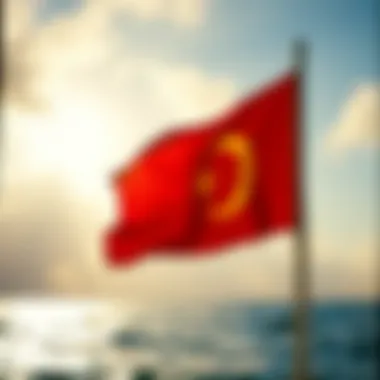
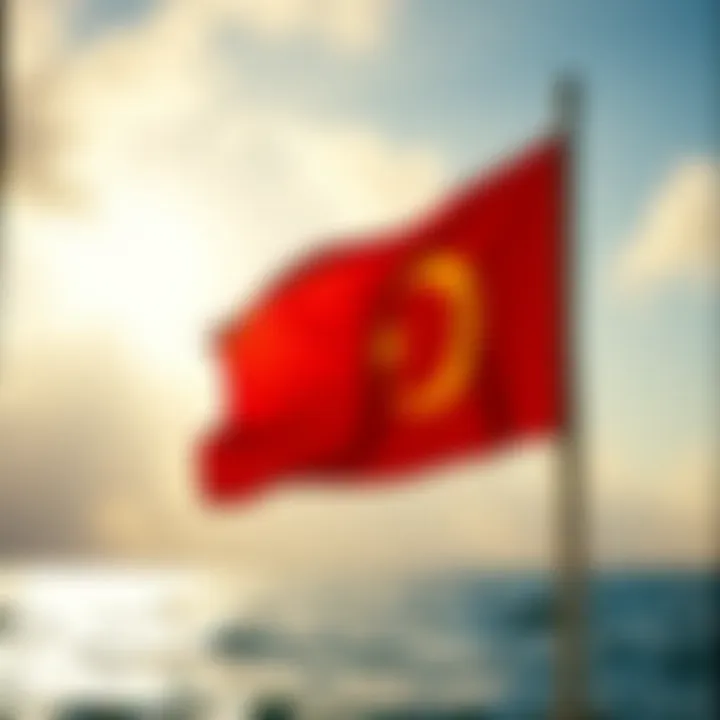
Decoding the Flags
Decoding nautical flags is essential for anyone navigating the waters. These flags are not merely decorative; each color, shape, and pattern carries a specific message that can mean the difference between smooth sailing and serious miscommunication. Understanding the signals transmitted by these flags empowers sailors to convey vital information even when they are far from the reach of electronic communication.
When it comes to maritime safety and cooperation, decoding flags is a cornerstone of effective communication. This section delves into the intricacies involved in understanding what these flags represent, their meanings in various contexts, and how they continue to function in modern-day sailing.
Individual Flag Meanings
Each flag in the nautical realm has a personality all its own, so to speak. Let's break down some commonly used flags and what they signify. Understanding individual flag meanings is akin to learning a new language; it opens up a rich dialogue between vessels at sea.
Here are a few flags and their meanings:
- Alpha Flag: This flag primarily signals that a vessel is engaged in diving operations, signaling others to keep clear.
- Bravo Flag: This one is raised during the transfer of hazardous cargo, urging nearby vessels to proceed with caution.
- Charlie Flag: When flown, this flag indicates that a ship is in need of assistance.
- India Flag: This flag tells others that the ship is in quarantine.
"Understanding these flags can enhance safety and coordination at sea, where every signal matters."
The significance of decoding these flags extends beyond mere communication; it embodies the tradition and culture relevant to the maritime community. The individual reasons behind these flags have historical roots, linking the past with the present.
Phonetic Alphabet Flags
The phonetic alphabet flags add another layer to the already intricate system of nautical communication. Each letter of the alphabet corresponds to a flag, facilitating clarity in verbal exchanges. For example, the flag for the letter 'A' resembles a triangle, while the flag for 'B' is composed of a square divided diagonally into two colors. This phonetic code is particularly valuable when weather conditions make verbal communication challenging; it helps ensure messages are understood despite the chaos around.
Understanding phonetic alphabet flags can be likened to deciphering a secret code, each letter carrying a message that can spell out significant commands. Familiarity with these flags can minimize the potential for mistakes in busy maritime settings.
For those looking to deepen their comprehension of nautical flags, resources are available at Wikipedia and general educational sites like Britannica. These can provide further insights into individual flag meanings and their usage in various maritime contexts.
Visual Elements of Nautical Flags
Nautical flags are not just simple pieces of cloth; they are intricate symbols steeped in history and meaning. Understanding the visual elements of these flags is essential for truly grasping their significance. The flags’ colors and designs convey specific messages that are instantly recognizable to seasoned mariners. This section explores the importance of color significance and design patterns, guiding you through the visual language of the sea.
Color Significance
Colors play a pivotal role in the communication conveyed by nautical flags. They not only attract attention quickly but also evoke specific emotions or denote particular meanings. For instance, the bright hue of red typically signals danger or a need to stop, while blue often denotes communication or information. Understanding these colors can transform a confusing assortment of flags into a coherent language.
- Red: Caution or danger.
- Blue: Information or communication.
- Yellow: Proximity or attention.
- White: Peace or neutrality.
By interpreting colors in conjunction with a flag's symbol, mariners can efficiently relay instructions, warnings, or announcements over long distances.
Consider this: when you see a yellow flag flown on a vessel, it typically indicates a warning of disease on board. This simple use of color can carry heavy implications for nearby boats and their crews.
In addition to their practical applications, colors can also represent various emotions or character traits associated with maritime culture. For example, blue is often considered a calming color, reflecting the tranquility and depth of the sea, while red, despite its warnings, is also a color of energy and passion—attributes often celebrated in the world of sailing.
Design Patterns
The design patterns on nautical flags are another layer of communication, serving as visual shorthand for complex messages. Each pattern is unique and purposeful, designed to be quickly recognized even from a distance. This is crucial in a maritime environment where conditions can change swiftly.
Flags may incorporate geometric shapes, stripes, or symbols that convey specific meanings. For example:
- Stripes: Often used in signal flags, stripes can indicate direction or urgency.
- Circles: Usually denote peaceful intent or the idea of coming together.
- Unique Symbols: Like anchors or stars, signify specific commands and signal needs directly.
When sailors hoist these flags, they employ a code that can be understood without needing complex explanations. This straightforwardness is vital in emergency scenarios, where time is of the essence. Imagine a regatta with numerous ships and racing flags flying; understanding design patterns can mean the difference between victory and confusion.
The combination of colors and design forms a rich tapestry of communication in the nautical world. As each flag snaps in the wind, it tells its own story, rich with cultural, historical, and functional significance. By mastering the visual elements, sailors can elevate their interaction with both the sea and their fellow mariners.
Usage Scenarios
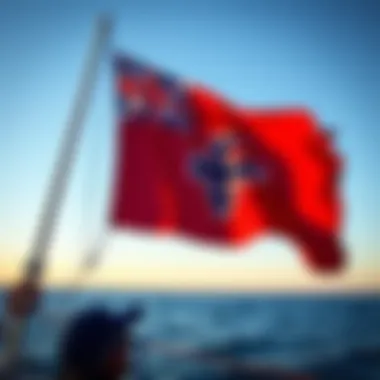
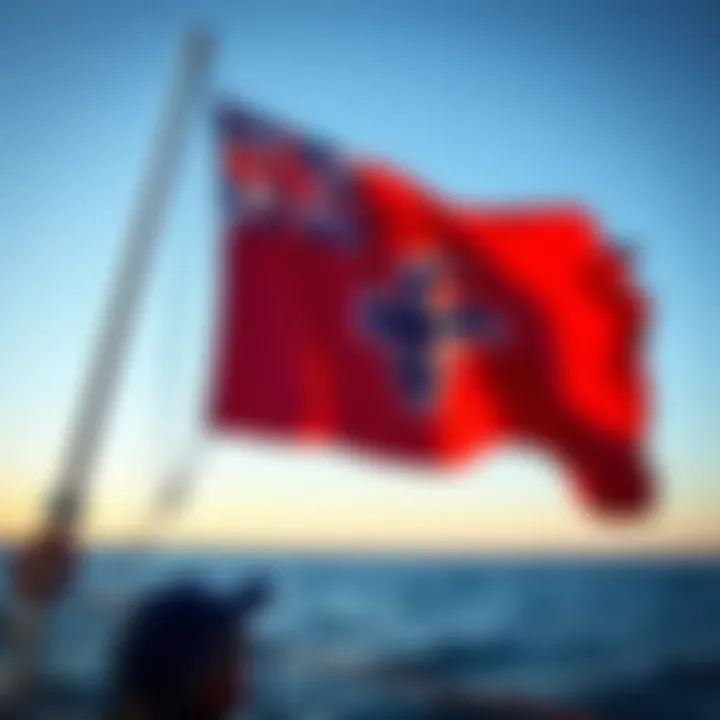
The world of nautical flags is not just about colors and patterns; it's about how these symbols weave into the fabric of maritime activity. Understanding the usage scenarios of nautical flags provides a glimpse into their practical application, greatly enhancing maritime communication within specific contexts. This section highlights the significance of these scenarios, with a focus on both onboard communication and competitive sailing events. By dissecting these aspects, readers will garner a better grasp of how nautical flags serve their crucial roles in real-world situations.
Onboard Communication
Onboard communication is a fundamental aspect of sailing and maritime operations. Here, flags become extensions of the sailors’ voices, conveying essential messages without uttering a single word. Whether it's a small boat with a handful of crew or a sprawling ship with hundreds aboard, nautical flags function to alert, inform, or warn.
For instance, a flag signaling 'man overboard' can rally a quick response in a life-threatening situation. Conversely, a simple signal can indicate a change in course or request assistance. Each flag's unique design and color bring clarity and urgency to these messages. When crew members are busy tending sails or navigating tricky waters, being able to understand these visual cues is indispensable.
The flags may vary depending on the context, but the primary benefit remains: swift, clear, and effective communication.
- Key Benefits of Onboard Communication:
- Immediate Understanding: Flags provide clarity in chaotic environments.
- Language Barriers Bridged: A visual language helps transcend different nationalities.
- Safety First: Critical informational alerts can save lives.
In essence, the ability to communicate onboard through flags ensures that hierarchies of command and teamwork remain effective, regardless of the ship’s size or the sea conditions.
Regatta and Competitive Sailing
When it comes to regattas and competitive sailing, nautical flags play a uniquely important role. Here, flags set the pace and rules of competition, marking key phases of the race with precision. A collection of flags governs everything from start times to penalties.
The starting line often features specific flags that dictate when the race will commence. The infamous blue flag typically signals that the race is about to start, stirring anticipation among competitors. Each hand signal, each flag flown, carefully orchestrates the event, ensuring all participants are on the same page. This regulatory aspect of flags is what differentiates a friendly sail from a full-blown competition.
A noteworthy point arises when considering penalties. A competitor who has violated a rule may be signaled with a red flag, indicating disqualification. The precision with which flags communicate these rules fosters fairness and transparency in racing, allowing competitors to focus on their performance and not on second-guessing the regulations.
- Benefits of Flags in Competitive Sailing:
- Visual Cues for Precision: Flags ensure competitors are aligned.
- Structured Competition: Clearly defined rules foster fairness.
- Enhanced Engagement: Spectators can easily follow proceedings.
In summary, nautical flags serve as the backbone of onboard communication and competitive scenarios, providing structure, clarity, and urgency to maritime activities. These situations underscore the evolving relevance of flags amidst modern technologies, ensuring their place in the pantheon of maritime tradition.
"Each flag flown is not merely a piece of cloth; it embodies communication’s essence, weaving safety and strategy into the fabric of nautical life."
For further exploration into the world of nautical signals, consider resources such as Wikipedia or Britannica. These platforms elaborate on the ins and outs of nautical communication, offering a wealth of information to deepen your understanding.
Nautical Flags in Modern Use
Nautical flags have weathered the storms of time and technology, holding steadfast as a symbol of maritime communication. Their relevance does not wane; instead, it evolves within the framework of modern technological integration and cultural dynamics. For sailors, both seasoned and novice, understanding the importance of these flags can enrich their experiences on the water.
Technological Integration
In today's digital age, one might mistakenly think that nautical flags are becoming obsolete, replaced by technology such as GPS and satellite communications. However, this isn't quite the case. The integration of technology with traditional nautical practices can actually enhance the significance of flags, rather than diminish it. Modern communication devices can fail or become unreliable. In emergencies, where a quick visual signal is needed, flags can convey messages faster than a malfunctioning gadget.
Additionally, automated systems on boats, like the Automatic Identification System (AIS), promote a greater requirement for visual signalling. When visibility is low or in crowded waters, ships still rely on flags to communicate intentions such as maneuvering or indicating distress. The clarity and immediacy that flags provide make them a vital tool in any sailor’s kit, regardless of technological advancements.
Continued Relevance
Nautical flags continue to serve not just as communication tools, but as a connection to maritime heritage and culture. While modern innovations have introduced new forms of communication, the flags remain essential in preserving traditional practices. They invoke a sense of unity among sailors, transcending language barriers and fostering camaraderie on the high seas.
Current trends show that yachting events and regattas still heavily utilize flags, both for their functional value and their vibrant visual appeal. Moreover, educational institutions and maritime academies emphasize the importance of understanding these flags as part of their curriculum. The need to learn and appreciate the meanings behind each flag continues in sailing schools, demonstrating their enduring relevance.
"Flags are more than just cloth; they symbolize a sailor’s bond with the sea."
In essence, the marriage of tradition and technology not only enhances the utility of nautical flags but also solidifies their place in modern maritime practices. For those passionate about sailing, flags weave a rich tapestry of communication, history, and community. Indeed, no sailor should overlook the importance of these flags in navigating the waters, now and into the future.
Cultural Interpretations
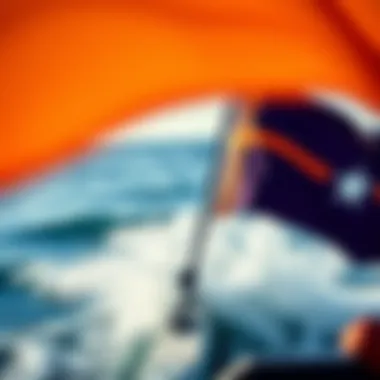
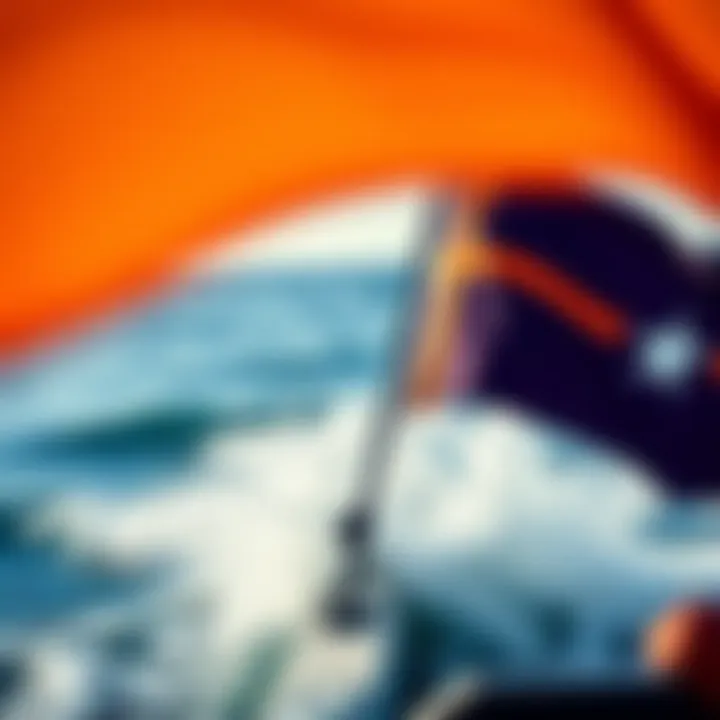
When it comes to nautical flags, their significance goes well beyond mere communication at sea. Cultural interpretations of these flags intertwine with local traditions, maritime legends, and the identity of coastal communities. Understanding these interpretations adds depth to our appreciation of these colorful pieces of fabric that flutter in the wind.
Regional Variations
Different regions interpret nautical flags through unique lenses. Take, for instance, the way coastal towns in the Mediterranean might infuse local imagery and colors into their flag systems. Here, flags are not only signals but also markers of heritage, representing fishing traditions or maritime history in particular towns.
- In southern Spain, vibrant flags depicting local sea life may be used during festivals. This impacts how sailors perceive the flags, as they encapsulate cultural pride and a shared sense of community.
- In contrast, Scandinavian countries often utilize the stark simplicity of design, reflecting a minimalistic aesthetic that ties closely with their broader cultural ethos.
- The waters around Hawaii showcase flags that are heavily influenced by indigenous culture, combining symbols that honor both ancestral spirits and the ocean itself.
Through these examples, it’s clear that the expressions woven into the fabric of nautical flags reflect complex social narratives, from historical allegiances to contemporary maritime practices.
National Flags vs. Nautical Flags
Understanding the distinction between national flags and nautical flags is critical in grasping how they function in communication. National flags, flown by countries, often embody the spirit, history, and values of a nation. They serve to unify citizens and instill a sense of patriotism. Nautical flags, on the other hand, have practical applications and are essential for daily maritime interactions.
- Symbolism: A national flag might bear a coat of arms or specific symbols that relate to the country’s history. In contrast, nautical flags utilize fundamental geometric shapes and colors designed for visibility and recognition.
- Purpose: While national flags signify allegiance and national pride, nautical flags convey messages specific to maritime operations. For example, the ‘A’ flag (Alfa) indicates a vessel is requesting medical assistance.
- Usage Context: A national flag is displayed at government buildings and during ceremonies. Meanwhile, nautical flags come into play on ships, signaling statuses or intentions among fellow sailors.
Both flag systems thrive within their own realms but serve entirely different roles. Understanding these nuances enriches one’s grasp of maritime culture and the visual lexicon that connects us to the ocean.
"Nautical flags are more than just colorful canvases; they are a reflection of the communities they come from, echoing their histories and identities, while conveying essential truths on the open sea."
Learning the Flags
Understanding the language of nautical flags is not just an academic exercise; it's an essential skill for anyone involved in maritime activities. Nautical flags serve as a bridge for communication across oceans and seas. They tell a story, convey urgency, and can even signal distress or celebration. Learning these flags equips enthusiasts, sailors, and travelers alike with a greater appreciation of the maritime world. It's like having a key that unlocks the secretive doors of seafaring communication.
Mastering nautical flags opens pathways not only to safety but also to camaraderie. Within the vibrant community of seafarers, a shared knowledge of this flag language fosters connections. Navy personnel and sailing amateurs alike effectively communicate even from a distance—no radios necessary.
Flag learning is not merely remembering shapes and colors, but understanding the story and purpose behind each one. From navigating to emergency signals, each flag acts as a part of a larger narrative that enriches maritime culture and safety.
Educational Resources
When diving into the world of nautical flags, various educational resources can enhance understanding. Here’s a rundown of valuable tools:
- Books and Manuals: Many publications are available that cover nautical communication, flag etiquette, and even historical context. The American Practical Navigator, also known as Bowditch, is an excellent starting point.
- Online Courses: Websites like Udemy offer courses specifically tailored to maritime communication, including lessons on flags.
- Interactive Apps: Mobile applications, such as Nautical Flags Quiz, provide engaging ways to learn through quizzes and flashcards, making repetition less tedious.
- Workshops and Seminars: Various boating schools and local sailing clubs often conduct workshops focusing on signaling with flags, giving hands-on experience that textbooks simply cannot offer.
- Visual Aids: Posters or laminated flag charts can serve as quick references while on deck or during training.
Utilizing these resources can provide a more profound grasp of the nuances in flag meanings and their usages in different contexts.
Training Programs
Engaging in structured training programs can dramatically speed up the learning process for nautical flags. Here are some of the notable options:
- Local Sailing Schools: Many sailing schools offer courses that cover the International Code of Signals and practical applications on the water. Attending these can spice up theoretical knowledge with real-world practice.
- Certification Programs: Organizations like the Royal Yachting Association provide certification courses. These often include modules on flag recognition and communication, adding credibility to one’s knowledge base.
- Community Learning: Joining a local yacht club can present chances for informal learning through conversations and experiences with seasoned sailors.
- Online Workshops: Many organizations hold webinars or online sessions focusing on advanced topics in maritime communication.
Training programs not only teach the flags but also instill confidence in users, knowing they can rely on these skills while out on the water. Whether a novice sailor or an experienced mariner, solid training in flag communication adds a layer of competence and enjoyment to any maritime journey.
"Nautical flags are the unsung heroes of maritime communication—simple yet profound in their impact."
In summary, learning about nautical flags is vital for anyone looking to engage with the maritime world. Equipping oneself with the relevant knowledge through varied resources ensures that both the sailor and the outdoor enthusiast can communicate effectively, appreciate tradition, and navigate safety through the vibrant language that these flags embody.
Closure
The maritime world thrives on communication, and nautical flags play a pivotal role in this dynamic. By diving into the enriching tapestry of nautical flags, one gains an appreciation not only for their historical significance but also for their continued relevance in today’s high-tech environment.
The Future of Nautical Flags
While we sail into the future, the evolution of nautical flags paints an interesting picture. The core of maritime tradition remains intact, yet technological advances bring about new layers of complexity to how we communicate at sea. Ships equipped with advanced communication systems still rely on flag signals, especially in scenarios where radio silence is essential.
It's crucial to understand that the essence of these flags isn't just in the physical presence; they encapsulate a rich maritime language that transcends borders. As cultures redefine their naval practices, regional variations of flag interpretations may emerge, enriching the diversity of this silent yet powerful medium.
Unearthing the importance of educating the next generation about these symbols seems paramount. Educational programs that include hands-on training with these flags can foster a deeper connection to seafaring traditions. Engaging youth through sailing schools and maritime museums can invigorate interest and respect for these flags, ensuring their legacy perseveres.
The balance between maintaining tradition and adapting to modernity will determine the fate of nautical flags. As we navigate ahead, these vibrant symbols remind us that even in an era dominated by screens and instant communication, the classic forms of maritime expression still hold significant value.
In summary, the future of nautical flags lies within the intricate web of technology, educational outreach, and cultural interpretation. These elements cater to the inherent need for connection amid the vast deep blue, echoing the call for sailors of all generations to heed the flags flying high above.







